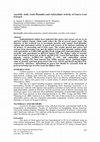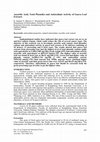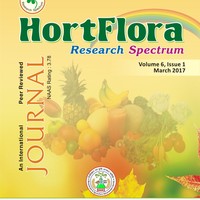Papers by kritsanee Iamjud

Acta horticulturae, Mar 1, 2014
Epidemiological studies have indicated that guava leaf extract can act as an anti-free radical re... more Epidemiological studies have indicated that guava leaf extract can act as an anti-free radical reagent, which could reduce the risk of several cancer types. The objective of this research was to investigate ascorbic acid content, total phenolics content and antioxidant activity in guava leaf extracts of 30 cultivars consisting of 10 dessert, 12 processing and 8 local types. The results showed that guava leaf extracts from processing type had the highest level of total phenolic content (gallic acid equivalents) at 5,304±1,485 mg/100 g fresh weight (FW) and antioxidant activity (ascorbic acid equivalents) at 685±135 µmol/g FW. The highest value of ascorbic acid was found in local type at 98±21 mg/100 g FW. Green leaf had higher value of phenolic content (4,584±1,710 mg/100 g FW) and antioxidant activity (559±242 µmol/g FW) than maroon leaf. While, maroon leaves contained higher value of ascorbic acid than green leaves that were 142±52 and 86±29 mg/100 g FW, respectively. Therefore, antioxidants in guava leaf should be extracted from the green processing type in order to get the highest value.
viii 4.10. change in absolute abundance of total fatty acid methyl esters (FAME), bacterial and f... more viii 4.10. change in absolute abundance of total fatty acid methyl esters (FAME), bacterial and fungal groups for sites 3.

Applied Biological Chemistry, 2017
Papaya fruit during the external color break stage is a valuable raw material to make food, but i... more Papaya fruit during the external color break stage is a valuable raw material to make food, but its benefits for human health are still limited. Ten selected Thai red-fleshed papaya genotypes during the external color break stage were investigated for morphological, physicochemical, and antioxidant property traits. Most fruit traits evaluated in this study varied significantly among genotypes. The smallest fruit genotype, SNP-KD, had the highest antioxidant activity (4.41 ± 0.62 lmol ascorbic acid equivalents/g fresh weight [FW]), ascorbic acid (838.1 ± 90.2 mg/L), and total phenolic (547.0 ± 52.8 mg gallic acid equivalents/kg FW), and the reddest flesh genotype, KM4-13, contained the highest lycopene (87.5 ± 14.7 mg/kg FW). The correlations between ascorbic acid and total soluble solids and between lycopene and b-carotene were relatively high at r = 0.72 and 0.69, respectively, which indicates a high correlation was possible for both selections. Antioxidant activity was only strongly positively correlated with total phenolics (r = 0.78), which indicates that the total phenolics was an important contributor to antioxidant activity in papaya flesh, and it was feasible to use total phenolics to indirectly estimate antioxidant activity.

ScienceAsia, 2016
Nine selected S 3 papaya breeding lines were evaluated for their antioxidant properties and fruit... more Nine selected S 3 papaya breeding lines were evaluated for their antioxidant properties and fruit quality. The 14 antioxidant properties and fruit quality traits measured in this study showed significant genotypic differences. KK80 showed the highest ascorbic acid content (114 ± 20 mg/100 ml), antioxidant activity (8.0 ± 1.3 µmol ascorbic acid equivalents/g fresh weight [FW]), and total phenolic compounds (72.2 ± 5.8 mg gallic acid equivalents/100 g FW). KD7 contained the highest amounts of total flavonoid (21.0 ± 5.8 mg catechin equivalents/100 g FW), lycopene (11.0 ± 1.7 mg/100 g FW), and β-carotene (10.0 ± 1.7 mg/100 g FW). The significant variation in antioxidant properties and fruit quality clearly shows the potential value of selected papaya breeding lines as new cultivars and parents in a breeding programme. Lycopene had a positive correlation with β-carotene (r = 0.62). Fruit size showed a negative correlation with total phenolic compounds (r = -0.64), antioxidant activity (r = -0.45), and ascorbic acid (r = -0.44). Flesh colour as hue angle was negatively correlated to lycopene (r = -0.67), suggesting that lycopene may be estimated indirectly by using the hue angle.

The objective of this experiment was to investigate seed number, weight, color and germination in... more The objective of this experiment was to investigate seed number, weight, color and germination in papaya. Seeds of 9 papaya varieties were extracted from 20-30% ripe fruits collected from hermaphrodite plants. Black, gray and white seeds with sarcotesta were then separated. Floated and sunken seeds were subsequently separated after sarcotesta was removed. Seeds were then shade dried (10% moisture content), weighed and tested for germination. Black, gray and white seeds were found in Koko, Koko Kandam, Kaem Maem, Rang Nairoy, Khaek Dam, Plug Mai Lai and Khaek Land; while Mexico Kaset and Sekaki found only gray and white seeds. Averaged number of seeds of sunken black, floated black, sunken gray, floated gray and floated white seeds was 93, 1, 163, 47 and 88 seeds/fruit, respectively. Seed weight and germination of sunken black, floated black, sunken gray, floated gray and floated white seeds were 1.77, 0.97, 1.44, 1.09 and 0.27 g/100 seeds and were 90, 33, 67, 35 and 0%, respectively...

Extraction solvents affected antioxidant contents in various fruits have been reported. The effec... more Extraction solvents affected antioxidant contents in various fruits have been reported. The effects of two extraction solvents [3% oxalic acid in 8% acetic acid (OAA) and water] and 100% guava juice (control) on ascorbic acid content were determined. Also, the effects of two extraction solvents (methanol and water) and 100% guava juice (control) on phenolic content and antioxidant activity of guava fruit extracts were investigated. The results showed that the lowest ascorbic acid content (88.5 mg/100 g), phenolic content (74.3 mg/100 g) and antioxidant activity (1.9 μmol/g) were obtained in 100% guava juice. There was no difference in ascorbic acid content in the extracts prepared by OAA and water. In addition, phenolic content and antioxidant activity in the extracts were similar whether prepared by methanol or water. Therefore, water should be used as an extraction solvent to prepare guava fruit extracts for determining antioxidant properties in guava fruit.

Inconsistency of fruit quality is an important problem for processed papaya industry. The objecti... more Inconsistency of fruit quality is an important problem for processed papaya industry. The objective of this research was to evaluate plant morphology and fruit quality of open pollinated population in ‘Kaem Maem’ processing papaya. Open pollinated seeds of ‘Kaem Maem’ were collected from Chachoengsao province. The seeds were then sown and planted at an experimental field of the Department of Horticulture, Kasetsart University, Kamphaeng Saen Campus, Nakhon Pathom province. Plant morphology and fruit quality were recorded from 30 hermaphrodite plants. The results showed that open pollinated plants of ‘Kaem Maem’ processing papaya had large variation in both plant morphological and fruit quality traits. At the first flowering stage, plant height varied from 90-160 cm, insertion height of the first flower varied from 68-115 cm, and number of node varied from 21-31 nodes. At the first fruit set stage, plant height varied from 170-245 cm, insertion height of the first fruit varied from 1...

‘Khaek Dam’ papaya is a traditional and an important commercial cultivar of Thailand for years.Du... more ‘Khaek Dam’ papaya is a traditional and an important commercial cultivar of Thailand for years.Due to papaya is a cross-pollinatedcrop and more than a few cultivars are planted together, mutation and variations of fruit quality of ‘Khaek Dam’ maybe occur. Therefore, this research was aim to study the vegetative growth and fruit quality of 7 ‘Khaek Dam’ papaya varieties collected from places of Thailand. Vegetative growth were evaluated as height to the first flower, number of node to the first flower, height to the first fruit and number of node to the first fruit. Fruit quality traitswere evaluated as fruit weight, fruit length and width, flesh thickness, flesh firmness and total soluble solids. Papaya plants were grown at an experimental field of the Department of Horticulture, Kasetsart University, KamphaengSaen Campus, NakhonPathom province.The resultsshowed clearly that vegetative growth and fruit quality of 7 ‘Khaek Dam’ varieties were different. Height to the first flower ran...

Papaya flowers produced in summer season are mostly unable to set fruit which may due to nonfunct... more Papaya flowers produced in summer season are mostly unable to set fruit which may due to nonfunctional pollens. This experiment determined the seasonal effect on viability and germination of papaya pollen. Eleven papaya cultivars consisting of ‘Khaek Dam’, ‘Sekaki ‘, ‘Pluk Mai Lai’, ‘Mexico Kaset’, ‘Khaek Land’, ‘Red Lady’, ‘Khon Kaen 80’, ‘Koko’, ‘Koko Kandam’, ‘Kaem Maem’ and ‘Rang Nairoy’ grown at the Tropical Vegetable Research Center, Kasetsart University, Kamphaeng Saen Campus, Nakhon Pathom province, were used. Viability and germination of papaya pollens which were collected from hermaphrodite plant were investigated in winter, summer, and rainy seasons of 2012. Pollen viability was tested by a staining method using 1% acetocarmine. Germination was tested by hanging drop technique with 10% sucrose pollen media. Results showed similarly seasonal effect on pollen viability and germination in all papaya cultivars. The highest value of pollen viability and germination was found i...

Acta Horticulturae, 2014
Epidemiological studies have indicated that guava leaf extract can act as an anti-free radical re... more Epidemiological studies have indicated that guava leaf extract can act as an anti-free radical reagent, which could reduce the risk of several cancer types. The objective of this research was to investigate ascorbic acid content, total phenolics content and antioxidant activity in guava leaf extracts of 30 cultivars consisting of 10 dessert, 12 processing and 8 local types. The results showed that guava leaf extracts from processing type had the highest level of total phenolic content (gallic acid equivalents) at 5,304±1,485 mg/100 g fresh weight (FW) and antioxidant activity (ascorbic acid equivalents) at 685±135 µmol/g FW. The highest value of ascorbic acid was found in local type at 98±21 mg/100 g FW. Green leaf had higher value of phenolic content (4,584±1,710 mg/100 g FW) and antioxidant activity (559±242 µmol/g FW) than maroon leaf. While, maroon leaves contained higher value of ascorbic acid than green leaves that were 142±52 and 86±29 mg/100 g FW, respectively. Therefore, antioxidants in guava leaf should be extracted from the green processing type in order to get the highest value.

Papaya is a source of ascorbic acid. To determine papaya ascorbic acid level by the standard meth... more Papaya is a source of ascorbic acid. To determine papaya ascorbic acid level by the standard method, the evaluated fruit is destroyed. The objective of this research was to develop a nondestructive method for determining ascorbic acid level in papaya fruit using near infrared spectroscopy technique. Near infrared (NIR) absorbance (spectra) of papaya fruit were acquired by a portable NIR spectrometer. Prediction equations of ascorbic acid level were developed by the relationship between ascorbic acid content and spectra using multiple linear regression analysis. There were two equations showing accurate prediction of ascorbic acid content. The multiple correlation coefficient (R), standard error of prediction (SEP) and bias of the first equation were 0.93, 8.78 mg/100 ml and -0.03 mg/100 ml and those of the second equation were 0.98, 4.56 mg/100 ml and -0.10 mg/100 ml, respectively. The first equation was suitable for determining ascorbic acid level for both harvesting and eating ind...










Uploads
Papers by kritsanee Iamjud